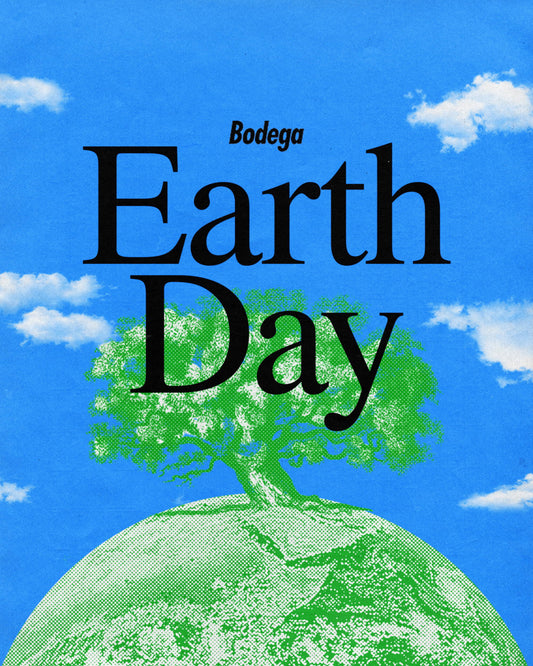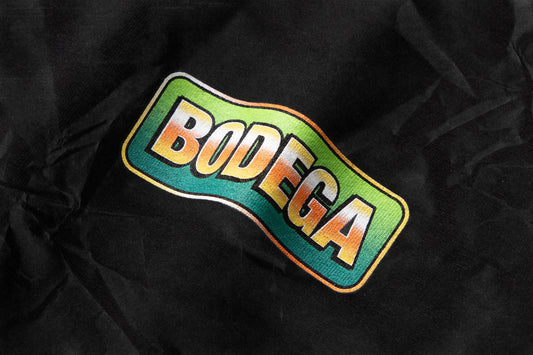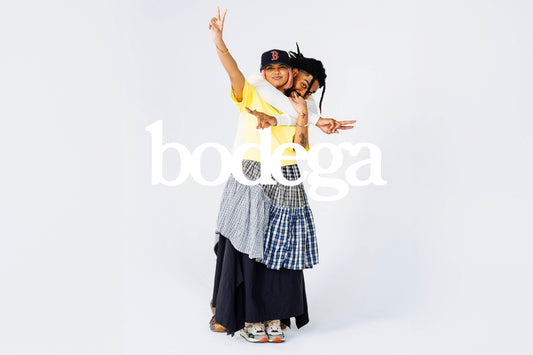Building his clothing brand and capturing people's attention through reimagining sustainable materials and deadstock fabrics, Peder Cho’s brand Utopia is setting the tone for a new lane in the clothing industry.
One where high-level production is brought to small-scale, ethical manufacturing. That's why, for our 4th Re-Creation Project with the Swoosh, we are excited to welcome Cho to the family. As part of his induction, we got the chance to sit down with Peder Cho and reconnect with Christine La, Sustainable Apparel Design Director at Nike, and Gery Petrov, Technical Design Lead at TEG, to talk about the collection and its impact on the industry at large.
Let’s take it back to the beginning Cho, your start in the clothing business is pretty inspiring.
Cho: I was in the business program at Marquette University in Milwaukee, WI aimlessly looking for which focus to study and ended up appreciating finance. Finance stood out to me to learn how businesses progress through startup, growth, and sales. I convinced myself I really enjoyed this, but with that said I did not excel in my classes. I graduated from Marquette, but struggled to find a “career job”. I stumbled upon a job opening for a mutual fund accountant role. With lack of excitement and motivation, I maintained a 4-year career despite falling out of love with it after several months.
So when was the moment you knew you wanted to take the leap into fashion?
Cho: My father owned a laundromat and as an accountant, who still wanted to be fresh, I would frequently get my suits tailored from his store. After doing this so many times the employees eventually taught me how to do it on my own.
I was gifted a sewing machine from my grandmother and I started tailoring all my suits and clothes at home.
Fortunately, I had my older brother as an example of a successful entrepreneur and he urged me that working for myself would be possible. This encouragement allowed me to start selling some of these one-off pieces to friends gradually becoming a little business where people would have me customize pieces for them.
The finance-to-upcycling pipeline isn’t exactly well-traveled though, right? What led you down that specific path?
Cho: The idea of upcycling never was planned. I just didn’t have a lot of money to allocate to starting a line, also not being convinced I was a good designer. This created a whole new outlook on storylines with clothing.
We all have garments in our closets that we can’t part ways with. Why? There’s a great sentiment we attach to things, clothes included. And those sentimental values kept coming through in my work. From baby blankets, and funeral service invitations to collected items that were gifted to our fallen loved ones. I’ve been a part of repurposing these items into something new that can be cherished, again, in a new way.
What about sewing - we know that can be its own rabbit hole.
Cho: I never once cared about sewing, art, or fashion until I was 25 years old. Sewing became an outlet for me to become my own boss. Once you love and dedicate yourself to something, time spent on doing it becomes irrelevant. You strive and you’d do anything to reach greatness.
There is a downside to that too, however. You sacrifice everything from relationships to your own well-being at times. Sometimes when I’m stressed about certain things I can pick up a project and for the next 4-12 hours my mind is clear. So sewing is an outlet for success and an escape for me.
How did moving to LA get things going?
Cho: Moving from Milwaukee, WI was one of the best decisions I’ve made in my design career. LA proved to be the catalyst that everyone speaks on. I was able to connect with designers, artists and my idols just 2 months after quitting my 9-5 job. I went to events solely to meet people then would leave to go back to my apartment and work. I offered my work to any creative I met just to be on their radar. Photographers and stylists really helped catapult me into working with bigger clients.
As I started in LA there’s little incentive for people to put you on unless you can come through in the clutch. So I lent my services to people for free oftentimes to establish these working bonds and that was another extremely beneficial sacrifice to gain a footprint in LA.
You have to adapt to the fast pace because everyone is working on a short timeline. This allows you to work with more people and grow faster. The best part of working in LA is the accessibility to big clients: individuals and brands. I do a lot of commissioned work for big brands and they all seem to have an office in LA, so that grants me access to meet them asap, and that in-person feel helps strengthen those bonds. You can’t replicate that over Zoom calls.
You just showed your debut collection at NYFW - what was that experience like? Was it a proof of concept that shows reinterpreted textiles do have a place in the major fashion conversation?
Cho: That experience was tremendous for me. Since 2019 I’ve been able to assist and design for some very recognizable brands that we are all familiar with. I’ve helped with shows and that gave me the opportunity to see behind the scenes and notice I’m not too far off. Having a successful brand and doing fashion shows is attainable and that seemed so far out of reach a year prior while I was working my 9-5 in Milwaukee.
Photos by Vanessa Le
I would agree that reinterpreted textiles do have a place in fashion conversation because one of the evergreen topics is that fashion is one of the most wasteful, environmentally harming industries in the world. That’s why there’s been a big push for upcycling. Even if the upcycling is just for show, which can warrant pushback, the demonstration of that process can inspire others to think differently.
Photos by Vanessa Le
Lets talk about Re-Creation for a sec - how did you first link up with Nike and how did it lead to this collab?
Cho: I first linked with Nike in 2021 from my work on Instagram. I started doing upcycle projects for Nike events in LA. Separately Nike Re-Creation hit me up maybe a year and a half ago to start working through this concept.
Nike is the best in many ways. Almost everyone you’ve ever known has their product. Of all the big brands I’ve worked with, they are truly leading the industry in conscious efforts through sustainability. Of course, any company with that magnitude can make people find areas of improvement, but at that operational size, no one is doing more to correct and shift the industry’s practices.
How did things progress from the Nike side Christine?
Christine: I think Cho might be one of the first independent designers we reached out to and started to work with for Re-Creation.
We wanted to create a distinction from conventional upcycled designs that tend to have that DIY look. Knowing this was the goal, the ideation to creation process was significantly more challenging than the normal process of designing with raw materials. Working with a designer in this space who shares these ideals, with discernment for craft and expertise in making was essential. Cho was already doing this on his own, so the collection came together quite organically.
In addition to being a talented designer, Cho’s outgoing nature has definitely helped him bring upcycling to a larger audience - what was the collaborative process like?
Christine: Having watched his videos, it’s amazing to see what Cho can create on his own. He’s a master craftsman as much as a designer. That ability to seamlessly navigate between both disciplines allowed us to collaborate on cut-and-sew designs more rapidly moving from ideas to physical concepts. Early on, working with Cho, I was surprised (maybe not too surprised) that he would skip the sketching and instead sew up prototypes to share at our design meetings. All this ultimately allowed us to confidently land a cohesive collection that much sooner.
On the development side of things. He’s been a great collaborator with our technical designers helping problem-solve issues when translating designs from reclaimed deadstock. He can really do it all and I think the magic happens when a singular talent is amplified by the might of Nike and all our resources.
Do you echo that Gery?
As always, this was a great experience working with Christine. The Utopia project offered a completely different style and product, which made it a challenge and something we enjoy taking on at TEG. In particular, the bags were a unique design requiring added thought to technically orchestrate. Cho was easygoing, creative, and a pleasure to work with.
"Here we’re taking old Nike garments that otherwise would have been thrown away, and give them a whole new life. The appreciation goes beyond the aesthetic. "
Speaking of those bags, how does Cho’s ability to see potential in forgotten textiles complement the goals of Nike Re-Creation as a whole?
Christine: What Cho recreates looks incredibly sharp and clean, yet thoughtfully retains its original soul. I think it’s a really smart way of applying the notion of respecting the past and creating the future. Striking that balance between transformation and reverence, through Cho’s specific streetwear fashion lens is the uniqueness that complements the move to zero goals by adding value back into these forgotten textiles and extending its life.
There’s also the community and process sharing side of Re-Creation which Kyle Wood who leads our Circular team always emphasizes matters most. It’s the ability to support local businesses, to provide education within a community which is a huge priority for Nike. It’s a big lift for us. So I think it’s incredibly inspiring for a young and independent designer such as Cho to also take on this responsibility.
Cho can you describe the inspiration for the collection and give the audience an overview of what to expect?
Cho: The inspiration is sustainability. I love how that idea can relate to different industries. I mainly gain inspiration from things outside of fashion. And this collection should do the same. Here we’re taking old Nike garments that otherwise would have been thrown away, and give them a whole new life. The appreciation goes beyond the aesthetic.
To add some context can you shout out some of your team’s favorite pieces/styles, Christine?
Christine: We all love the Abs and Lattice bags having seen versions from Cho’s runway and videos. To see such familiar Nike styles like the Tech Fleece or our track jacket Wind Runner recontextualized into his bag designs is so unusual it seems almost exotic and therefore a must-have.
One of my personal favorites is probably the ISPA reflective bag. Having worked on the original pant style and remembering the challenges of bringing this design to life with engineered 3M reflective jacquard fabric to all reflective bungee, cord locks, pullers, and trims. I never imagined then that I would one day see it upcycled. I humbly admit it looks more interesting in its second life.
What about you Gery?
Gery: The team and I enjoyed creating the Barrel Bag. It's so unique, and we've never created anything similar, which was a fun challenge. It played to our team's strengths, which we always enjoy being able to use. Also, the Coach's jacket, with the twist of the windbreaker style having armhole openings, allows it to be used in other ways. I really appreciate that aspect.
"There’s a very DIY feel when it comes to upcycling, but I dedicate every day to showing that it doesn’t have to be that way. You can still make an amazing garment that looks “factory made” from already existing clothes."
Cho back to you -with all this said, how do you see this collection impacting the larger conversation of sustainability within the clothing industry?
Cho: There’s a very DIY feel when it comes to upcycling, but I dedicate every day to showing that it doesn’t have to be that way. You can still make an amazing garment that looks “factory made” from already existing clothes. When you have all the resources at hand you can make anything. But, the constraints of using clothes to create something new forces you to be creative and think outside of the box.
From the TEG perspective, when you reflect back on the collection Gery, what impression do you hope it makes?
Gery: We have stood for sustainability, making clothes ethically in LA, and promoting independent design, for nearly 20 years now at TEG. We are all pleased to see Nike form these important collaborations and explore new ways of showing their commitment to these values as well. I hope this comes across as a shared set of values as it really took a team effort to orchestrate it amongst all groups involved.
Any shoutouts to close out Cho?
Cho: Shoutout to Christine La, Kyle Wood, and Kris Leeper for leading this entire movement through Nike. Nike already has an industry-leading division focusing on sustainability, but Re-Creation gives the “flowers” to local independent designers. Collaborating with Nike is another thing that seems unattainable, but this program grants that accessibility.







